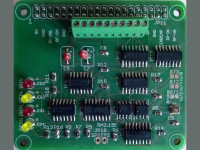The Capturing-Remote-Controller with a Raspberry Pi

With the Raspberry Pi based Capturing-Remote-Controller you can record and transmit control codes of a remote controller based on both infrared and radio signals.
When is an universal remote control really universal?
The characteristics of the Capturing-Remote-Controller
• With the Capturing-Remote-Controller you can easily record and transmit control codes of a remote controller based on both infrared and (for the time being only) 344MHz radio signals.
• The Capturing-Remote-Controller can be operated with its console controls, but also ("headless" and Ethernet) by any device that has a web browser of any origin (Android, Apple or Microsoft). Therefore, no specific brand-dependent apps are required to control the Capturing-Remote-Controller.
• The software of the Capturing-Remote-Controller is designed for the Raspberry Pi with the operating system Raspbian. The complete source code of the Capturing-Remote-Controller is ready for use, fully available and free. The software mainly consists out of Python, Flask, HTML and CSS.
• Especially the user interfaces can easily be adapted for individual applications. The front-end software for user interfaces and the more specialized hardware driver software are therefore separated.
Support is provided by real functioning user interfaces. Therefore some basic knowledge of mainly HTML, CSS and programming will be sufficient to easily create an intuitive user interface for every application. See the images below with some examples.
• Some customization examples:
- The changing of the language used.
- The number and type of buttons.
- The number of the user interfaces is adaptable and the posibility to switch between them.
- Buttons have the possibility to repeat their remote command.
- A button can control other buttons.
So one button can send several remote control codes to control several systems in the same time.
• The Capturing-Remote-Controller consists of an Addon Board (Hat) and a sensor unit.
See the pictures "CRC-HAT" and "Sensor unit" below.
• Possible extensions
The computing capacity and the still available gpio of the Raspberry Pi are more than sufficient to add many extra functions, such as:
- Applications with two-way communication.
- Applications that use dynamic (changing) codes.
- Combinations with an existing (home automation) system.
Who would like to produce and sell these printed circuits with soldered (SMD) components?




Updates vom Autor
R. Heijstek vor 6 Jahren